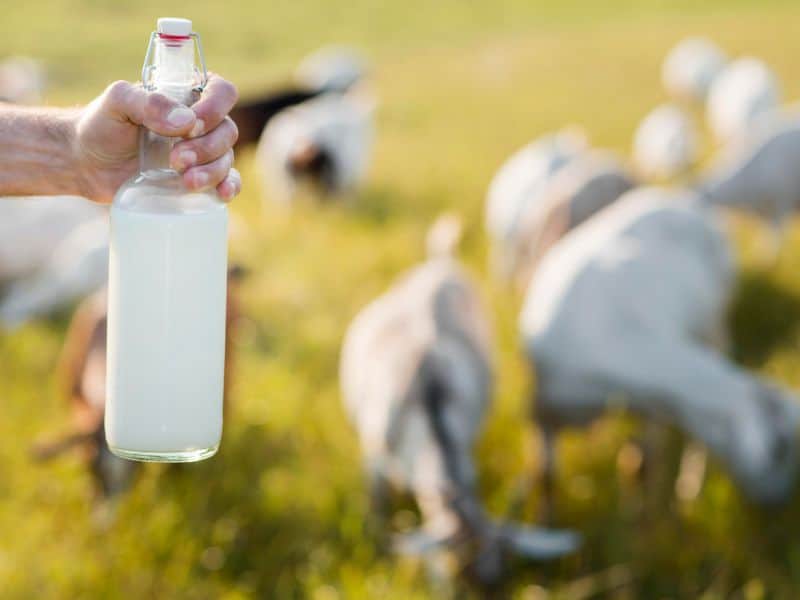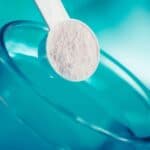Soap can be made with a wide variety of ingredients and additives both natural and synthetic but soap can also be made with milk. Many handmade and artisan soaps contain milk either in powdered form or as an added ingredient such as goat milk. The question is why do you put milk in soap and what are the benefits?
Milk is added to soap to provide skin-nourishing benefits such as hydration and exfoliation. Milk contains natural fats, vitamins, and minerals that help to moisturize the skin and create a creamy lather.
The natural fats in the milk help to create a soap that is gentle on the skin and helps to condition dry, irritated skin. Milk also contains lactic acid which helps to gently exfoliate the skin without being harsh or abrasive. Milk-based soaps can be beneficial for those with sensitive skin since they are less likely to irritate it. Let’s take a closer look at the science behind milk in soap.
The Science Behind Milk in Soap-Making
Properties of Milk
Milk is a complex mixture of proteins, fats, and sugars, along with vitamins and minerals. These components provide nourishment to the body and also offer several benefits when used in soap-making.
How Milk Affects Soap-Making
Milk contains lactic acid, which helps to break down the proteins in the milk, making it easier for the soap-making process to occur. Milk also contains natural fats, which moisturize the skin and provide a creamy lather to the soap.
Chemical Reactions Involved in Soap-Making with Milk
Soap is made by combining fats or oils with a strong alkaline solution. When milk is added to the soap-making process, the lactic acid in the milk reacts with the alkaline solution to create a chemical reaction called saponification.
This reaction creates soap and glycerin, which moisturizes the skin.
Types of Milk Soap
Goat Milk Soap
Goat milk soap is one of the most popular types of milk soap. Goat milk is rich in vitamins and minerals, making it a nourishing ingredient for the skin. Goat milk soap is also gentle on sensitive skin and helps to soothe skin irritations.
Cow Milk Soap
Cow milk soap is another popular type of milk soap. Cow milk is rich in butterfat, which moisturizes the skin and helps to create a creamy lather. Cow milk soap is also ideal for people with dry skin, as it helps to hydrate the skin and lock in moisture.
Vegan Milk Soap
Vegan milk soap is made using plant-based milk, such as almond milk, coconut milk, or soy milk. These milks provide similar benefits to animal milk, such as moisturizing and nourishing the skin. Vegan milk soap is an excellent option for people who follow a vegan lifestyle.
Benefits of Milk Soap
Skin Benefits of Using Milk Soap
Milk is known for its numerous benefits for the skin. Milk soap is packed with vitamins and minerals, such as vitamin A, D, and E, which are essential for healthy skin. Milk soap also contains lactic acid, which acts as a natural exfoliant, gently removing dead skin cells and leaving the skin soft and smooth.
Advantages of Using Milk Soap Over Commercial Soap
Commercial soap is often loaded with harsh chemicals and synthetic fragrances that can irritate the skin. Milk soap, on the other hand, is made with natural ingredients and is gentle on the skin. Milk soap also contains natural fats that moisturize the skin, leaving it feeling soft and hydrated.
Personal Experiences with Milk Soap
Many people have reported positive experiences with using milk soap. People with dry or sensitive skin have found that milk soap is gentle and hydrating. Others have noticed an improvement in skin texture, with a reduction in acne and other skin blemishes.
Common Mistakes to Avoid When Making Milk Soap
Overheating the Milk
One common mistake when making milk soap is overheating the milk. If the milk gets too hot, it can scorch and produce an unpleasant odor. It can also curdle, making it difficult to mix with the other ingredients.
Using the Wrong Type of Milk
Not all types of milk are suitable for soap-making. Milk with high fat content, such as heavy cream, can make the soap too greasy. Milk with low-fat content, such as skim milk, may not provide enough nourishment for the skin. It’s important to choose the right type of milk for your soap recipe.
Not Properly Measuring Ingredients
Soap-making is a science, and it’s essential to measure ingredients accurately. Not measuring ingredients correctly can result in an unsuccessful batch of soap. It’s essential to follow the recipe precisely to ensure that the soap turns out as intended.
Milk Soap versus Other Types of Soap
Comparison between Milk Soap and Glycerin Soap
Glycerin soap is a transparent soap that is known for its moisturizing properties. It is often used in commercial soaps because it is inexpensive to produce. However, glycerin soap may not be as nourishing as milk soap.
Milk soap contains natural fats that moisturize the skin, leaving it feeling soft and hydrated.
Comparison between Milk Soap and Castile Soap
Castile soap is a type of soap that is made from olive oil. It is known for its gentle and moisturizing properties. Castile soap is a good option for people with sensitive skin.
However, milk soap may offer more skin benefits than Castile soap. Milk soap contains lactic acid, which acts as a natural exfoliant, gently removing dead skin cells and leaving the skin soft and smooth.
Which Type of Soap is Best for You?
The type of soap that is best for you depends on your skin type and personal preferences. Milk soap is a good option for people with dry or sensitive skin, as it is gentle and moisturizing. Glycerin soap is a good option for people who want a more affordable soap.
Castile soap is a good option for people with sensitive skin or who prefer a soap made with natural ingredients.
Pros and Cons of Adding Milk to Soap
Milk is a popular ingredient in soap-making due to its nourishing properties for the skin. However, like any ingredient, there are both pros and cons to adding milk to soap.
Pros of Adding Milk to Soap:
- Moisturizing: Milk contains natural fats and vitamins that help to moisturize and hydrate the skin. Adding milk to soap can help to create a creamy, moisturizing lather that leaves the skin feeling soft and smooth.
- Exfoliating: Milk contains lactic acid, which acts as a natural exfoliant, gently removing dead skin cells and revealing healthy, radiant skin. This can be beneficial for people with rough or dull skin.
- Gentle: Milk is gentle on the skin and less likely to irritate it than commercial soaps that contain harsh chemicals and synthetic fragrances. This makes milk soap an excellent option for people with sensitive skin.
- Versatile: Milk can be added to a variety of soap recipes, including cold process soap, hot process soap, and melt and pour soap. This makes it a versatile ingredient for soap-makers to use in their formulations.
Cons of Adding Milk to Soap:
- Short shelf life: Milk-based soap has a shorter shelf life than other types of soap. Milk can spoil and create an unpleasant odor, which can make the soap unsuitable for use. This means that milk soap should be used or stored properly to prevent spoilage.
- Temperature sensitivity: Milk is sensitive to high temperatures and can scorch or curdle if not handled correctly. Soap-makers must take care when working with milk to ensure that it is not overheated.
- Limited availability: Some types of milk, such as goat milk, may not be readily available in all areas. This can make it difficult for soap-makers to source the milk they need for their recipes.
- Cost: Milk can be an expensive ingredient to use in soap-making, particularly if using high-quality, organic milk. This can make milk soap more expensive to produce than other types of soap.
Milk to soap can provide numerous benefits for the skin, including moisturization, exfoliation, and gentleness. However, there are also some drawbacks. Ultimately, the decision to use milk in soap-making will depend on personal preferences and the desired benefits for the skin.
Tips for Making Milk Soap at Home
Properly Preparing the Milk
When making milk soap, it’s essential to properly prepare the milk. The milk should be heated slowly and gently to avoid scorching. It should also be cooled before adding the lye to avoid curdling.
Choosing the Right Fragrance and Essential Oils
Adding fragrance and essential oils can enhance the scent and therapeutic properties of the soap. It’s essential to choose oils that are safe for skin and to avoid using too much oil, which can cause skin irritation.
Using Natural Colorants
Adding natural colorants can give the soap a beautiful, natural hue. It’s essential to use natural colorants that are safe for the skin, such as clay or cocoa powder.
Frequently Asked Questions
Milk soap offers several benefits for the skin, including hydration, exfoliation, and nourishment. Milk soap contains natural fats, lactic acid, vitamins, and minerals that moisturize and exfoliate the skin, leaving it feeling soft and smooth.
Milk soap can be made with a variety of types of milk, including cow milk, goat milk, and plant-based milks such as almond milk or coconut milk. Each type of milk offers its unique benefits for the skin.
Yes, milk soap is gentle and moisturizing, making it an excellent option for people with sensitive skin. Milk soap contains natural ingredients that are less likely to irritate the skin than commercial soap, which may contain harsh chemicals and synthetic fragrances.
Milk soap can last for several months to a year, depending on how it is stored and how often it is used. Properly storing milk soap in a cool, dry place can help to extend its shelf life.
Conclusion
In conclusion, when you put milk in soap it can create a luxurious type of soap that offers numerous benefits for the skin. When compared to other types of soap, milk soap contains natural fats, lactic acid, and other skin-nourishing ingredients that moisturize and exfoliate the skin.
Whether you prefer glycerin soap, Castile soap, or milk soap, it’s important to choose a soap that suits your skin type and personal preferences.






